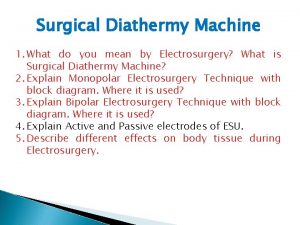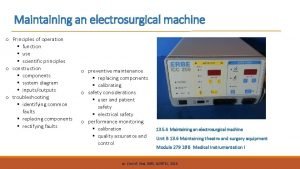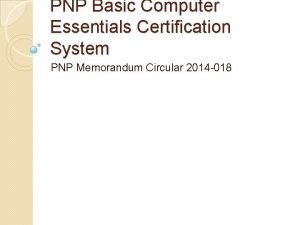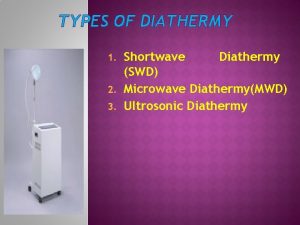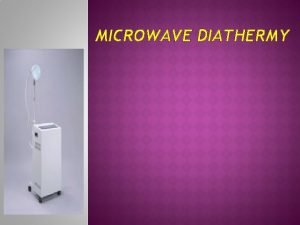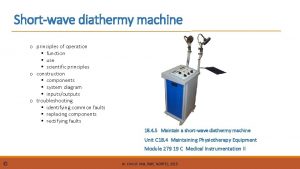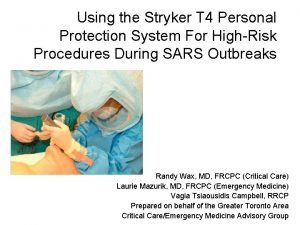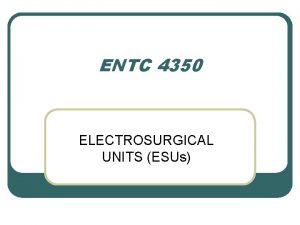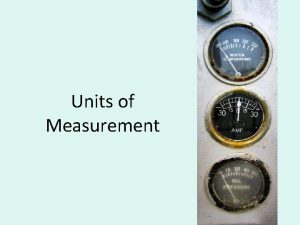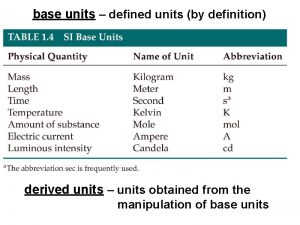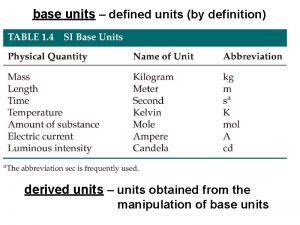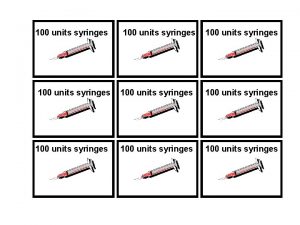XX Electrosurgical Units Surgical diathermy TRAINING SEMINAR ON



























- Slides: 27

XX. Electrosurgical Units (Surgical diathermy) TRAINING SEMINAR ON MEDICAL DEVICE ACCIDENT INVESTIGATION for Kingdom of Saudi Arabia Saudi Food & Drug Authority Riyadh 11 -14 February, 2007 Presenter: Mark E. Bruley Vice President, Accident and Forensic Investigation ECRI 5200 Butler Pike, Plymouth Meeting, PA, 19642 USA Tel: +1 610 -825 -6000, ext. 5223 E-mail: mbruley@ecri. org Web Sites: www. ecri. org www. mdsr. ecri. org ©ECRI 2007 1

X. Electrosurgical Units • Electrosurgical Basics • Electrosurgical Burns • Laparoscopic Accidents • Injuries to Medical Staff • Fires ©ECRI 2007 2

Some Basic Electrosurgery Facts • Used in about 80% of all surgical procedures • Very effective surgical tool – Cutting – Coagulation – Fulguration • Not well understood by clinicians • Commonly seen in FDA and ECRI problem reporting databases ©ECRI 2007 3

A Primer on Electrosurgery Arrows indicate flow of electrical current in a complete circuit. M 005 XN 9 B-01 ©ECRI 2007 4

Monopolar Electrosurgical Current Flow Current is concentrated at the active electrode to produce cutting or coagulation; it is dispersed at the return electrode to prevent patient burns. M 005 XN 9 B-02 ©ECRI 2007 5

Bipolar Electrosurgery Electrosurgical Unit Current Flow Tissue between tips of forceps ©ECRI 2007 6

Electrosurgery Safety Features • Continuity Monitor – Verifies that a return electrode is connected to electrosurgical unit – Cannot detect if return electrode is disconnected from or in poor contact with the patient – Single- or dual-foil dispersive electrode may be used ©ECRI 2007 7

Electrosurgery Safety Features … • Return Electrode Contact Quality Monitor (RECQM) – Offers better level of protection than continuity monitor – Assures that good contact exists between the dispersive electrode and patient – Uses interrogation current through patient tissues to verify acceptable impedance level – Dual-foil dispersive electrode must be used – ECRI strongly recommends using electrosurgical units with RECQM ©ECRI 2007 8

Dual Plate Return Electrodes Interrogation current flows between each plate of the electrode and the patient. If one side is partially detached from the patient, an alarm will sound. ©ECRI 2007 9

Electrosurgical Accidents • Skin Burns • Fires, Explosions – Fuels/Gases/Oxygen Enriched Atmospheres • Power Delivered – Too much (Eyelid; Testicle) – Too little (Fallopian tube) • Organ Perforations ©ECRI 2007 10

Spermatic Cord Damage from Electrosurgery (old technology, new procedure, bad outcome) ©ECRI 2007 11

Misconnection Problem Figure 1. Flexible bipolar electrode cables can allow misconnection of bipolar leads into the monopolar jacks, resulting in serious patient injury. M 005 XN 9 B-04 ©ECRI 2007 12

Electrosurgical Accidents • Argon Beam Coagulators – Gas Embolism • Interference (EMI) – ESU as “Source” of EMI versus being a “Sink” • User Injuries – Hand sensation – Alternate pathways ©ECRI 2007 13

Electrosurgical Injuries • Return Electrode Issues – Poor electrode placement – Lack of skin prep – Complete or partial removal of return electrodes – Skin reactions to adhesives – Edge effects – Patients with limited viable skin surface area – High electrosurgical currents and long activation times ©ECRI 2007 14

Electrosurgical Injuries … • Active Electrode Issues – Insulation surrounding conductive shaft • Breakdown – Repeated Sterilization – Cuts, Nicks, Abrasions • Capacitive Coupling – Electrical current induced by means of capacitance to other instruments or tissues • Tip “flare-ups” • Inadvertent activation! ©ECRI 2007 15

Electrosurgical Injuries • Active Electrode – Organ Perforations – Alternate Site Burns (Use an Holster!) – Laparoscopic Active Electrodes – Laparoscopic Cannula Burns – Spermatic Cord – Fallopian Tube – Failure to use activation tone ©ECRI 2007 16

Active Electrode Accidents • Inadvertent activation of the ESU due to unintentional switch activation – User places active electrode on the patient or the surgical drape between intended activations – Safety holster not used – Audible activation tone volume is set too low • Insulation failure along shaft during procedures, such as tonsillectomy causing burn to tissue inside mouth or to lip • User makes direct contact with nontarget tissue ©ECRI 2007 17

Electrosurgical Injuries • Return Electrode – Poor Site Preparation – Poor Application technique – Non-uniform Conductivity – Repositioning • Patient • Electrode ©ECRI 2007 18

Return Electrode Accidents • Burns – Use of electrolytic (conductive) distention/irrigation media during TURP – Conductive solution may render electrosurgery less effective – Disperses current away from intended surgical site – Lower surgical effect may lead user to increase power output of ESU – Conductive solution lowers impedance at active electrode, elevating current – Increased power and lower impedance increases current through dispersive return electrode ©ECRI 2007 19

Laparoscopic Electrosurgery • • Monopolar vs. Bipolar Current leakage though cannula Insulation breakage Fire ©ECRI 2007 20

Laparoscopic Injuries • • • Inadvertent tip to tissue contact Insulation failures Capacitive coupling Trocar insertion sites Device interference Resulting in bowel perforations, excess bleeding, damage to nontarget tissue, etc. ©ECRI 2007 21

Figure 2. Inadvertent energizing of a conductive instrument (in this case, a laparoscope introduced through a nonconductive cannula) from contact with active electrode tip during ESU activation. M 005 XN 9 B-05 ©ECRI 2007 22

Figure 3. Insulation failure within a conductive trocar cannula. M 005 XN 9 B-06 ©ECRI 2007 23

Figure 4. Insulation failure within a conductive trocar cannula that has been insulated from the insertion site. M 005 XN 9 B-07 ©ECRI 2007 24

Figure 4. Insulation failure outside the trocar cannula. M 005 XN 9 B-08 ©ECRI 2007 25

ESU-caused Fires • • See surgical fires Heat, sparks, flaming gases Not a device problem Micro-environment of use ©ECRI 2007 26

XX. Electrosurgical Units (Surgical diathermy) QUESTIONS? ©ECRI 2007 27
 Electrodes used in surgical diathermy
Electrodes used in surgical diathermy Electrosurgical unit principle
Electrosurgical unit principle Types of esu
Types of esu Botox dosage forehead
Botox dosage forehead Variable costing income statement
Variable costing income statement Computer training seminar memo
Computer training seminar memo National training seminar
National training seminar Chicago management training seminar
Chicago management training seminar Difference between swd and mwd
Difference between swd and mwd Microwave diathermy block diagram
Microwave diathermy block diagram Short wave diathermy definition
Short wave diathermy definition Precautions of swd
Precautions of swd Block diagram of microwave diathermy
Block diagram of microwave diathermy Curapulse
Curapulse Diathermy plate placement
Diathermy plate placement Principle of diathermy
Principle of diathermy Microwave diathermy frequency
Microwave diathermy frequency Aappm
Aappm Stryker scrub cap
Stryker scrub cap Surgical sieve vitamin c
Surgical sieve vitamin c Cloroprep
Cloroprep Inductive vs deductive learning
Inductive vs deductive learning Surgical audit definition
Surgical audit definition Dorsal recumbent
Dorsal recumbent Surgical metabolism
Surgical metabolism Surgical metabolism
Surgical metabolism Surgical planning laboratory
Surgical planning laboratory Surgical metabolism
Surgical metabolism
